Public Policy Report: Affordable Housing and Homelessness in Hawaii
VerifiedAdded on 2022/11/10
|11
|2390
|410
Report
AI Summary
This report examines the critical issue of affordable housing and homelessness in Hawaii, highlighting the state's unique challenges due to its geographical isolation, high cost of living, and low wages. The study delves into the demographics of the homeless population, including youth, the LGBT community, seniors, and veterans, while exploring the underlying causes of cost-barrenness, such as insufficient income, high utility costs, regressive taxation, and transportation expenses. The report proposes two alternative solutions: ensuring housing for all, and reducing the cost of taxation, weighing the pros and cons of each approach. The criteria for evaluating the policy's effectiveness are also outlined, focusing on minimal impact to current homeowners, maintaining health and hygiene, respecting cultural and religious beliefs, and adherence to environmental and citizenship regulations. The report concludes by emphasizing the need for a comprehensive and inclusive policy framework to address the complex issue of homelessness and promote affordable housing in Hawaii.
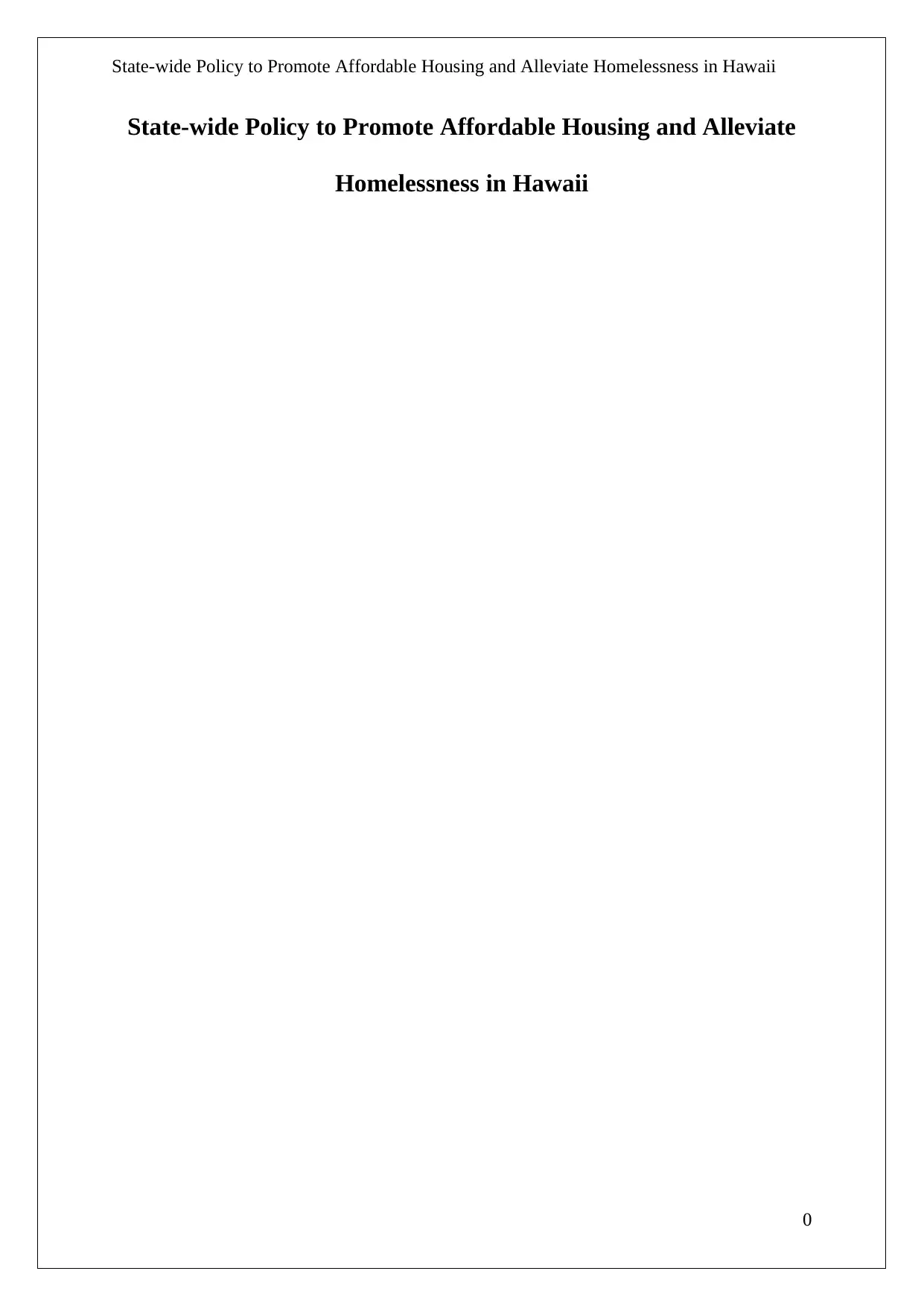
State-wide Policy to Promote Affordable Housing and Alleviate Homelessness in Hawaii
State-wide Policy to Promote Affordable Housing and Alleviate
Homelessness in Hawaii
0
State-wide Policy to Promote Affordable Housing and Alleviate
Homelessness in Hawaii
0
Paraphrase This Document
Need a fresh take? Get an instant paraphrase of this document with our AI Paraphraser

State-wide Policy to Promote Affordable Housing and Alleviate Homelessness in Hawaii
Define the Problem
One of the world’s most desirable places for living, Hawaii Island is facing a severe
issue of the homelessness crisis. The geographical location of Hawaii creates outstanding
isolation which leads it to be the highest demanding visiting place for tourists. This demand
for the location intensifies the housing cost whereas the low wages lead to the low
affordability for the housing. The disparity between income and housing affordability along
with insufficient housing development creates a daily struggle for the citizens of Hawaii.
Homelessness is a complex social phenomenon that adversely affects the state by decreasing
the values of the community. This homelessness issue also affects the tourism industry of the
island by creating negative impression on the visitors.
This study focuses on the demographics of homeless people based on age and gender
while providing solution for each criterion. The study addressed the tender aged youth whose
families are imprisoned or abused them. The study discusses the problem of transgender or
the people of LGBT community while seeking housing in Hawaii. The history of eviction
caused by gender identity or gender discrimination arises the need for policymaking under
fair housing act.
The state government identifies the estimated public cost for street-living people
ranging from $35,000 to $150,000 per head annually (Thompson, 2013). This cost
encompasses the cost for healthcare, frequent emergency room visit, police, and related cost,
temporary shelter, and other social services. Even the well-resourced families are facing
homelessness for the increasing cost of housing driven up by the challenges of rise of land
price, high construction cost, and development cost. The homelessness is also caused by the
long history of poverty-related challenges and also for those who are being refused by the
landlords for previous criminal records; the renters fail to meet the conditions of the renters
1
Define the Problem
One of the world’s most desirable places for living, Hawaii Island is facing a severe
issue of the homelessness crisis. The geographical location of Hawaii creates outstanding
isolation which leads it to be the highest demanding visiting place for tourists. This demand
for the location intensifies the housing cost whereas the low wages lead to the low
affordability for the housing. The disparity between income and housing affordability along
with insufficient housing development creates a daily struggle for the citizens of Hawaii.
Homelessness is a complex social phenomenon that adversely affects the state by decreasing
the values of the community. This homelessness issue also affects the tourism industry of the
island by creating negative impression on the visitors.
This study focuses on the demographics of homeless people based on age and gender
while providing solution for each criterion. The study addressed the tender aged youth whose
families are imprisoned or abused them. The study discusses the problem of transgender or
the people of LGBT community while seeking housing in Hawaii. The history of eviction
caused by gender identity or gender discrimination arises the need for policymaking under
fair housing act.
The state government identifies the estimated public cost for street-living people
ranging from $35,000 to $150,000 per head annually (Thompson, 2013). This cost
encompasses the cost for healthcare, frequent emergency room visit, police, and related cost,
temporary shelter, and other social services. Even the well-resourced families are facing
homelessness for the increasing cost of housing driven up by the challenges of rise of land
price, high construction cost, and development cost. The homelessness is also caused by the
long history of poverty-related challenges and also for those who are being refused by the
landlords for previous criminal records; the renters fail to meet the conditions of the renters
1
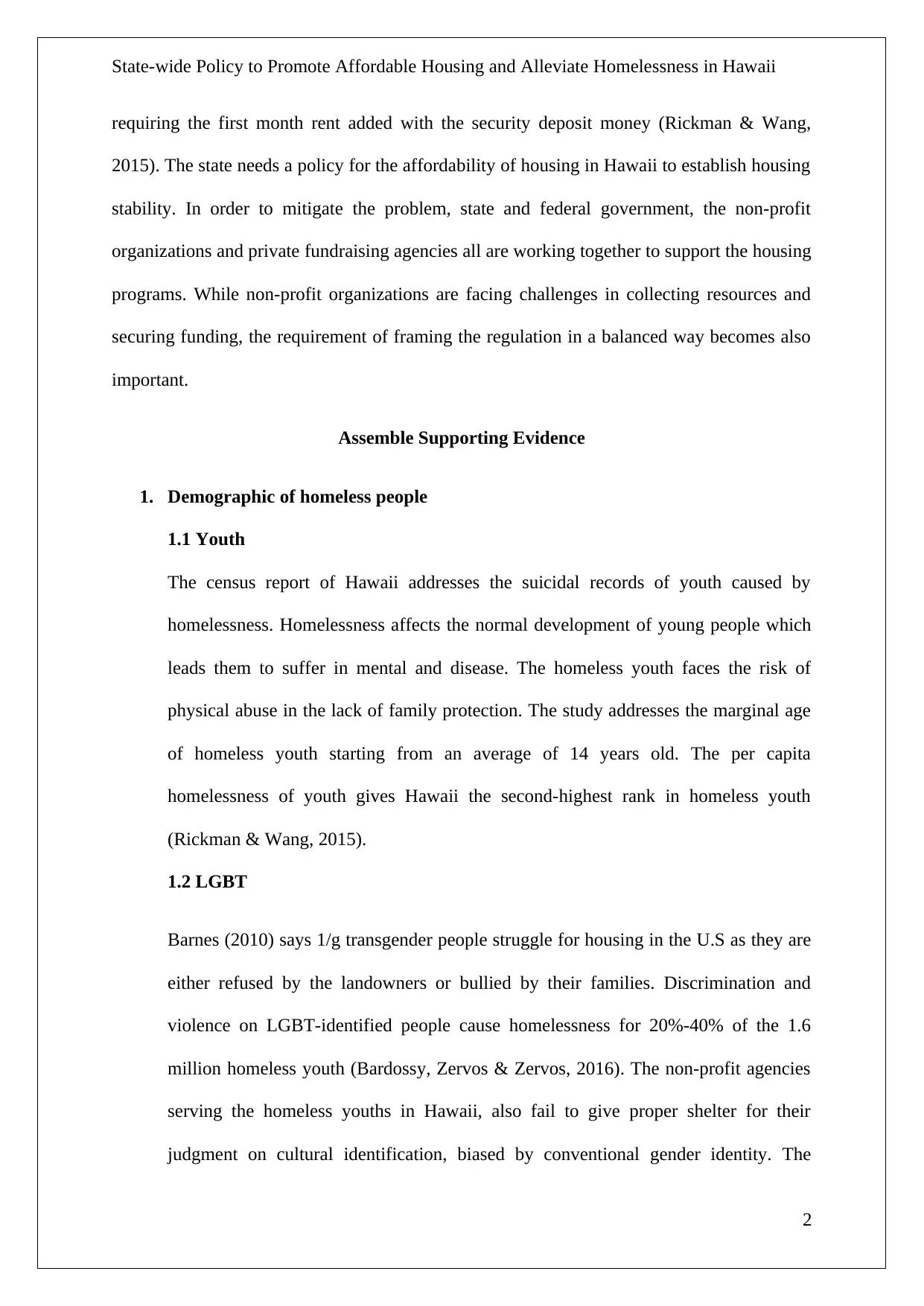
State-wide Policy to Promote Affordable Housing and Alleviate Homelessness in Hawaii
requiring the first month rent added with the security deposit money (Rickman & Wang,
2015). The state needs a policy for the affordability of housing in Hawaii to establish housing
stability. In order to mitigate the problem, state and federal government, the non-profit
organizations and private fundraising agencies all are working together to support the housing
programs. While non-profit organizations are facing challenges in collecting resources and
securing funding, the requirement of framing the regulation in a balanced way becomes also
important.
Assemble Supporting Evidence
1. Demographic of homeless people
1.1 Youth
The census report of Hawaii addresses the suicidal records of youth caused by
homelessness. Homelessness affects the normal development of young people which
leads them to suffer in mental and disease. The homeless youth faces the risk of
physical abuse in the lack of family protection. The study addresses the marginal age
of homeless youth starting from an average of 14 years old. The per capita
homelessness of youth gives Hawaii the second-highest rank in homeless youth
(Rickman & Wang, 2015).
1.2 LGBT
Barnes (2010) says 1/g transgender people struggle for housing in the U.S as they are
either refused by the landowners or bullied by their families. Discrimination and
violence on LGBT-identified people cause homelessness for 20%-40% of the 1.6
million homeless youth (Bardossy, Zervos & Zervos, 2016). The non-profit agencies
serving the homeless youths in Hawaii, also fail to give proper shelter for their
judgment on cultural identification, biased by conventional gender identity. The
2
requiring the first month rent added with the security deposit money (Rickman & Wang,
2015). The state needs a policy for the affordability of housing in Hawaii to establish housing
stability. In order to mitigate the problem, state and federal government, the non-profit
organizations and private fundraising agencies all are working together to support the housing
programs. While non-profit organizations are facing challenges in collecting resources and
securing funding, the requirement of framing the regulation in a balanced way becomes also
important.
Assemble Supporting Evidence
1. Demographic of homeless people
1.1 Youth
The census report of Hawaii addresses the suicidal records of youth caused by
homelessness. Homelessness affects the normal development of young people which
leads them to suffer in mental and disease. The homeless youth faces the risk of
physical abuse in the lack of family protection. The study addresses the marginal age
of homeless youth starting from an average of 14 years old. The per capita
homelessness of youth gives Hawaii the second-highest rank in homeless youth
(Rickman & Wang, 2015).
1.2 LGBT
Barnes (2010) says 1/g transgender people struggle for housing in the U.S as they are
either refused by the landowners or bullied by their families. Discrimination and
violence on LGBT-identified people cause homelessness for 20%-40% of the 1.6
million homeless youth (Bardossy, Zervos & Zervos, 2016). The non-profit agencies
serving the homeless youths in Hawaii, also fail to give proper shelter for their
judgment on cultural identification, biased by conventional gender identity. The
2
⊘ This is a preview!⊘
Do you want full access?
Subscribe today to unlock all pages.

Trusted by 1+ million students worldwide
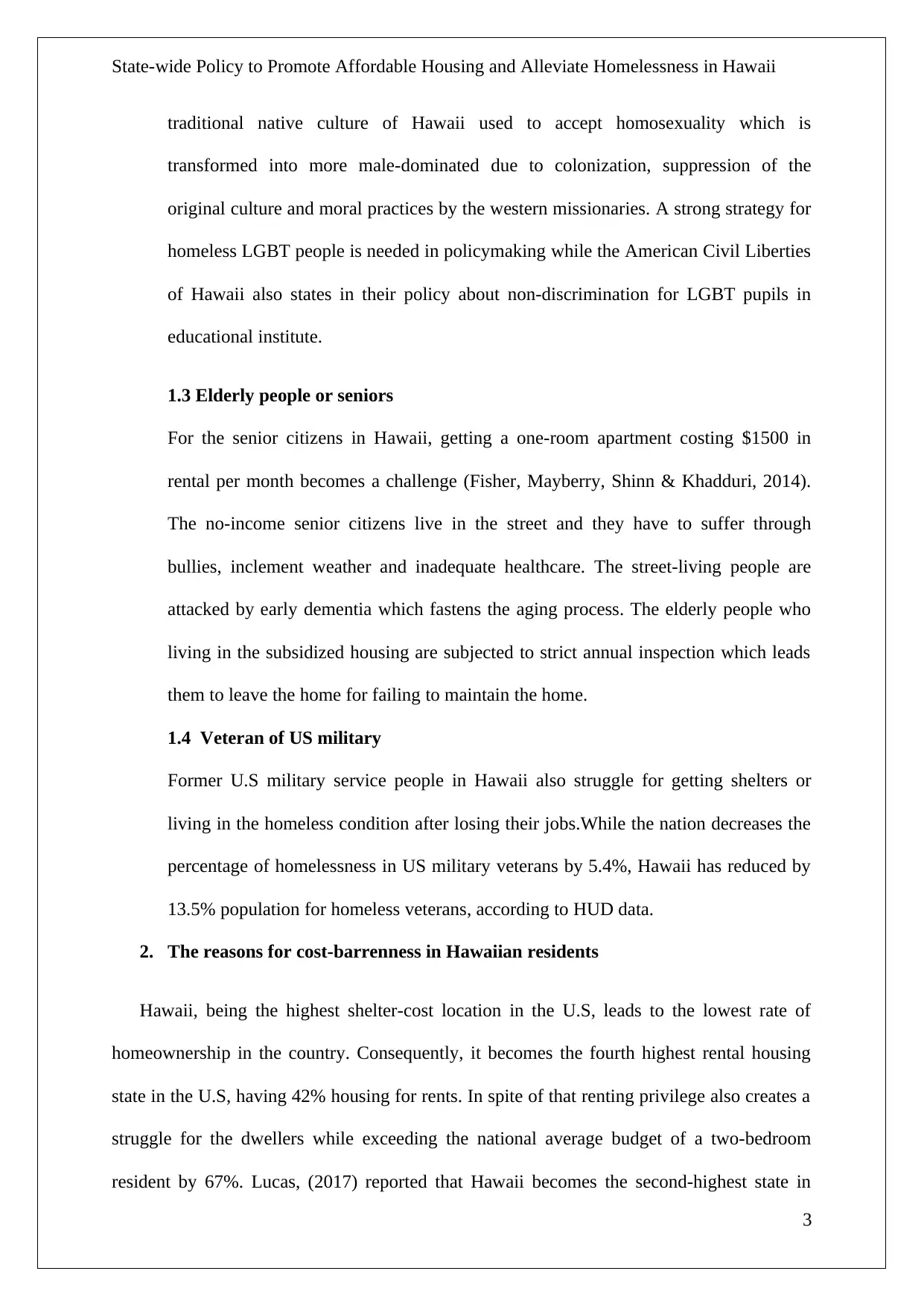
State-wide Policy to Promote Affordable Housing and Alleviate Homelessness in Hawaii
traditional native culture of Hawaii used to accept homosexuality which is
transformed into more male-dominated due to colonization, suppression of the
original culture and moral practices by the western missionaries. A strong strategy for
homeless LGBT people is needed in policymaking while the American Civil Liberties
of Hawaii also states in their policy about non-discrimination for LGBT pupils in
educational institute.
1.3 Elderly people or seniors
For the senior citizens in Hawaii, getting a one-room apartment costing $1500 in
rental per month becomes a challenge (Fisher, Mayberry, Shinn & Khadduri, 2014).
The no-income senior citizens live in the street and they have to suffer through
bullies, inclement weather and inadequate healthcare. The street-living people are
attacked by early dementia which fastens the aging process. The elderly people who
living in the subsidized housing are subjected to strict annual inspection which leads
them to leave the home for failing to maintain the home.
1.4 Veteran of US military
Former U.S military service people in Hawaii also struggle for getting shelters or
living in the homeless condition after losing their jobs.While the nation decreases the
percentage of homelessness in US military veterans by 5.4%, Hawaii has reduced by
13.5% population for homeless veterans, according to HUD data.
2. The reasons for cost-barrenness in Hawaiian residents
Hawaii, being the highest shelter-cost location in the U.S, leads to the lowest rate of
homeownership in the country. Consequently, it becomes the fourth highest rental housing
state in the U.S, having 42% housing for rents. In spite of that renting privilege also creates a
struggle for the dwellers while exceeding the national average budget of a two-bedroom
resident by 67%. Lucas, (2017) reported that Hawaii becomes the second-highest state in
3
traditional native culture of Hawaii used to accept homosexuality which is
transformed into more male-dominated due to colonization, suppression of the
original culture and moral practices by the western missionaries. A strong strategy for
homeless LGBT people is needed in policymaking while the American Civil Liberties
of Hawaii also states in their policy about non-discrimination for LGBT pupils in
educational institute.
1.3 Elderly people or seniors
For the senior citizens in Hawaii, getting a one-room apartment costing $1500 in
rental per month becomes a challenge (Fisher, Mayberry, Shinn & Khadduri, 2014).
The no-income senior citizens live in the street and they have to suffer through
bullies, inclement weather and inadequate healthcare. The street-living people are
attacked by early dementia which fastens the aging process. The elderly people who
living in the subsidized housing are subjected to strict annual inspection which leads
them to leave the home for failing to maintain the home.
1.4 Veteran of US military
Former U.S military service people in Hawaii also struggle for getting shelters or
living in the homeless condition after losing their jobs.While the nation decreases the
percentage of homelessness in US military veterans by 5.4%, Hawaii has reduced by
13.5% population for homeless veterans, according to HUD data.
2. The reasons for cost-barrenness in Hawaiian residents
Hawaii, being the highest shelter-cost location in the U.S, leads to the lowest rate of
homeownership in the country. Consequently, it becomes the fourth highest rental housing
state in the U.S, having 42% housing for rents. In spite of that renting privilege also creates a
struggle for the dwellers while exceeding the national average budget of a two-bedroom
resident by 67%. Lucas, (2017) reported that Hawaii becomes the second-highest state in
3
Paraphrase This Document
Need a fresh take? Get an instant paraphrase of this document with our AI Paraphraser

State-wide Policy to Promote Affordable Housing and Alleviate Homelessness in Hawaii
cost-burdened households renters, as 54% renters of Hawaii are cost-burdened. The study
addresses some reasons for cost-barrenness:
Insufficient income for housing
The fair market rent for a two-bedroom apartment in the state costs $1,640, while a
family requires at least annual earnings of $65,600 or per month income of $5,467 for
meeting the housing needs in a fair market rate (Zenou, 2012). The state government must
include housing wage in the income of Hawaiian, for affording two-bedroom apartment
costing $31.54, as per fair market rent. It denotes that a renter in Hawaii must earn $13.86 per
hour for meeting the needs of rental housing. Trueland (2009) explains an individual must
work 91 hours per week to acquire that hourly wage. Canady (2017) analyses that a full-time
minimum wage worker in Hawaii must work for 52 weeks, equivalent to 174 hours for
affording a two-bedroom apartment. The disparity between lack of housing wage and rise of
housing cost affects the low-income populations in Hawaii. In order to pay 30% income for
housing rent, 87% low-income families become cost-burdened. After paying a huge
percentage in housing rents, the low-income families are left for struggling in fulfilling other
needs along with high taxes, food consumption cost and other necessities of day-to-day life.
As a result, they have to cut costs in buying nutritious foods and transportation costs. Hilton
& Trella (2014) showed the people lacking the affordability of housing, are the determinants
of poor health indicators. They have to share their housing with friends and relatives to fulfill
economic necessities. Hawaii has ranked for the ninth highest rate of poverty-driven areas in
the U.S, while more than 17% residents are surviving for meeting their basic needs.
Utility cost and taxing system
Low, Hallett & Mo, (2016) reflected on the utility costs which creates pressures on
the residential sector in Hawaii, costing 37 cents per kilowatt-hour. The electricity cost makes
4
cost-burdened households renters, as 54% renters of Hawaii are cost-burdened. The study
addresses some reasons for cost-barrenness:
Insufficient income for housing
The fair market rent for a two-bedroom apartment in the state costs $1,640, while a
family requires at least annual earnings of $65,600 or per month income of $5,467 for
meeting the housing needs in a fair market rate (Zenou, 2012). The state government must
include housing wage in the income of Hawaiian, for affording two-bedroom apartment
costing $31.54, as per fair market rent. It denotes that a renter in Hawaii must earn $13.86 per
hour for meeting the needs of rental housing. Trueland (2009) explains an individual must
work 91 hours per week to acquire that hourly wage. Canady (2017) analyses that a full-time
minimum wage worker in Hawaii must work for 52 weeks, equivalent to 174 hours for
affording a two-bedroom apartment. The disparity between lack of housing wage and rise of
housing cost affects the low-income populations in Hawaii. In order to pay 30% income for
housing rent, 87% low-income families become cost-burdened. After paying a huge
percentage in housing rents, the low-income families are left for struggling in fulfilling other
needs along with high taxes, food consumption cost and other necessities of day-to-day life.
As a result, they have to cut costs in buying nutritious foods and transportation costs. Hilton
& Trella (2014) showed the people lacking the affordability of housing, are the determinants
of poor health indicators. They have to share their housing with friends and relatives to fulfill
economic necessities. Hawaii has ranked for the ninth highest rate of poverty-driven areas in
the U.S, while more than 17% residents are surviving for meeting their basic needs.
Utility cost and taxing system
Low, Hallett & Mo, (2016) reflected on the utility costs which creates pressures on
the residential sector in Hawaii, costing 37 cents per kilowatt-hour. The electricity cost makes
4
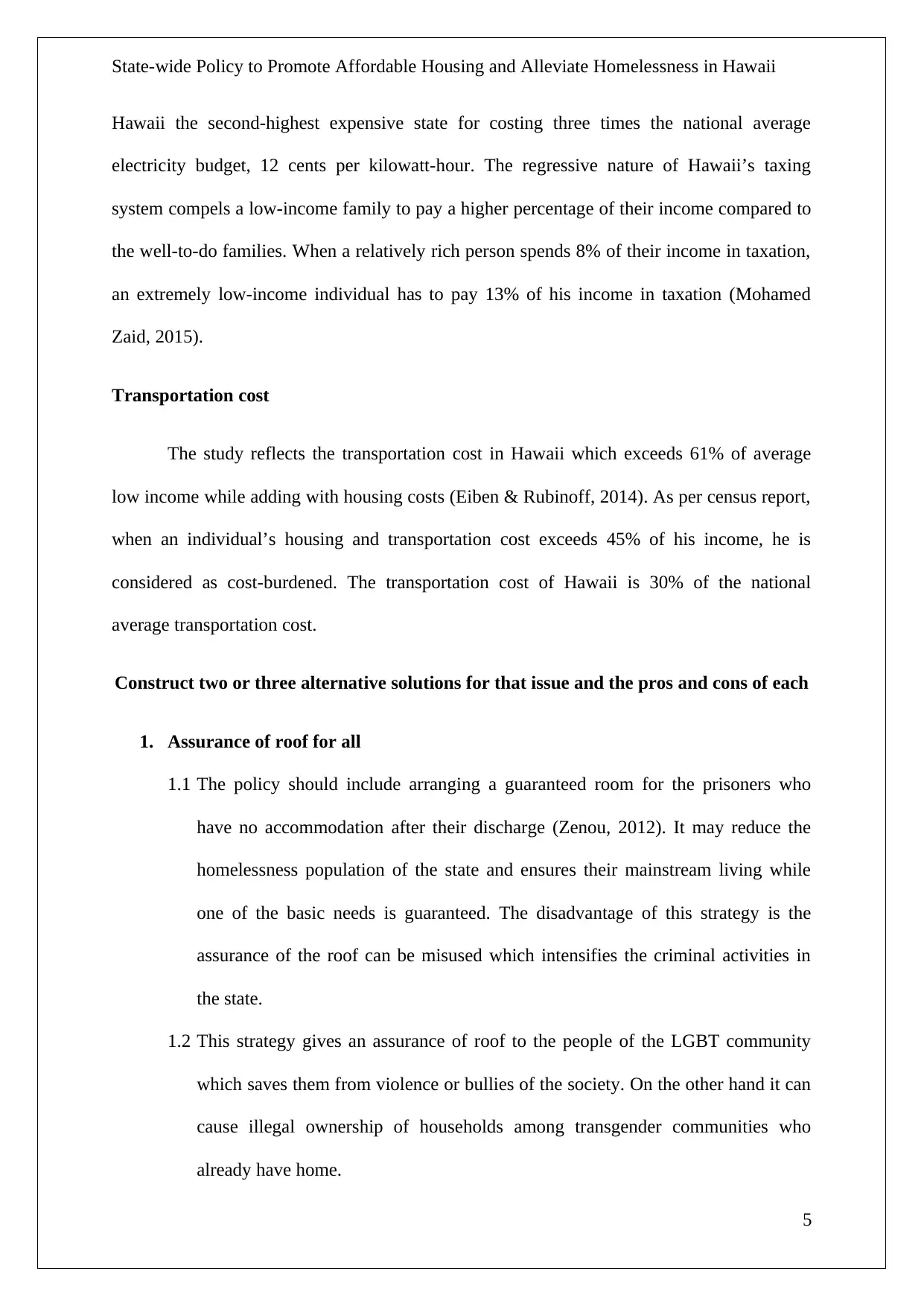
State-wide Policy to Promote Affordable Housing and Alleviate Homelessness in Hawaii
Hawaii the second-highest expensive state for costing three times the national average
electricity budget, 12 cents per kilowatt-hour. The regressive nature of Hawaii’s taxing
system compels a low-income family to pay a higher percentage of their income compared to
the well-to-do families. When a relatively rich person spends 8% of their income in taxation,
an extremely low-income individual has to pay 13% of his income in taxation (Mohamed
Zaid, 2015).
Transportation cost
The study reflects the transportation cost in Hawaii which exceeds 61% of average
low income while adding with housing costs (Eiben & Rubinoff, 2014). As per census report,
when an individual’s housing and transportation cost exceeds 45% of his income, he is
considered as cost-burdened. The transportation cost of Hawaii is 30% of the national
average transportation cost.
Construct two or three alternative solutions for that issue and the pros and cons of each
1. Assurance of roof for all
1.1 The policy should include arranging a guaranteed room for the prisoners who
have no accommodation after their discharge (Zenou, 2012). It may reduce the
homelessness population of the state and ensures their mainstream living while
one of the basic needs is guaranteed. The disadvantage of this strategy is the
assurance of the roof can be misused which intensifies the criminal activities in
the state.
1.2 This strategy gives an assurance of roof to the people of the LGBT community
which saves them from violence or bullies of the society. On the other hand it can
cause illegal ownership of households among transgender communities who
already have home.
5
Hawaii the second-highest expensive state for costing three times the national average
electricity budget, 12 cents per kilowatt-hour. The regressive nature of Hawaii’s taxing
system compels a low-income family to pay a higher percentage of their income compared to
the well-to-do families. When a relatively rich person spends 8% of their income in taxation,
an extremely low-income individual has to pay 13% of his income in taxation (Mohamed
Zaid, 2015).
Transportation cost
The study reflects the transportation cost in Hawaii which exceeds 61% of average
low income while adding with housing costs (Eiben & Rubinoff, 2014). As per census report,
when an individual’s housing and transportation cost exceeds 45% of his income, he is
considered as cost-burdened. The transportation cost of Hawaii is 30% of the national
average transportation cost.
Construct two or three alternative solutions for that issue and the pros and cons of each
1. Assurance of roof for all
1.1 The policy should include arranging a guaranteed room for the prisoners who
have no accommodation after their discharge (Zenou, 2012). It may reduce the
homelessness population of the state and ensures their mainstream living while
one of the basic needs is guaranteed. The disadvantage of this strategy is the
assurance of the roof can be misused which intensifies the criminal activities in
the state.
1.2 This strategy gives an assurance of roof to the people of the LGBT community
which saves them from violence or bullies of the society. On the other hand it can
cause illegal ownership of households among transgender communities who
already have home.
5
⊘ This is a preview!⊘
Do you want full access?
Subscribe today to unlock all pages.

Trusted by 1+ million students worldwide
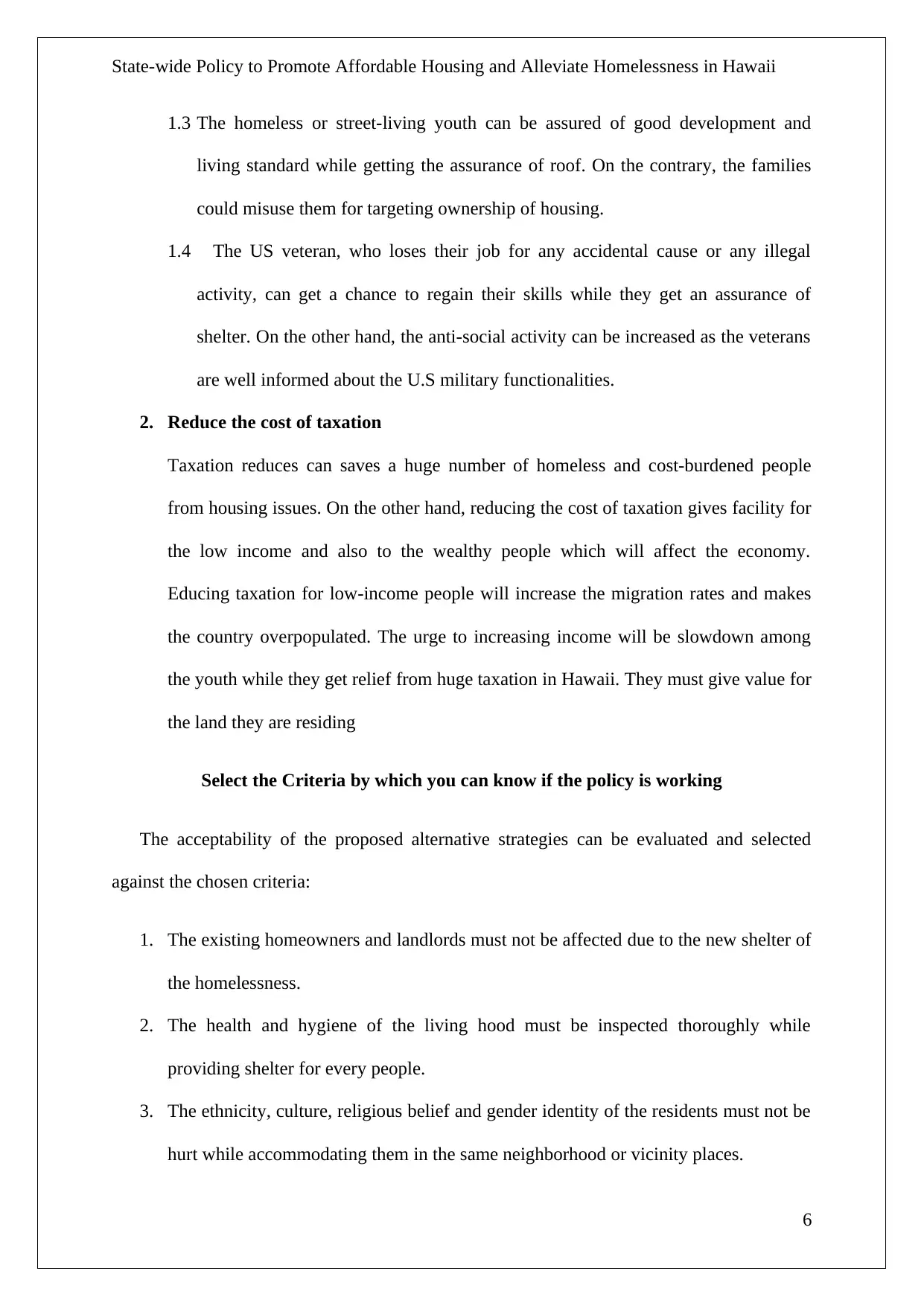
State-wide Policy to Promote Affordable Housing and Alleviate Homelessness in Hawaii
1.3 The homeless or street-living youth can be assured of good development and
living standard while getting the assurance of roof. On the contrary, the families
could misuse them for targeting ownership of housing.
1.4 The US veteran, who loses their job for any accidental cause or any illegal
activity, can get a chance to regain their skills while they get an assurance of
shelter. On the other hand, the anti-social activity can be increased as the veterans
are well informed about the U.S military functionalities.
2. Reduce the cost of taxation
Taxation reduces can saves a huge number of homeless and cost-burdened people
from housing issues. On the other hand, reducing the cost of taxation gives facility for
the low income and also to the wealthy people which will affect the economy.
Educing taxation for low-income people will increase the migration rates and makes
the country overpopulated. The urge to increasing income will be slowdown among
the youth while they get relief from huge taxation in Hawaii. They must give value for
the land they are residing
Select the Criteria by which you can know if the policy is working
The acceptability of the proposed alternative strategies can be evaluated and selected
against the chosen criteria:
1. The existing homeowners and landlords must not be affected due to the new shelter of
the homelessness.
2. The health and hygiene of the living hood must be inspected thoroughly while
providing shelter for every people.
3. The ethnicity, culture, religious belief and gender identity of the residents must not be
hurt while accommodating them in the same neighborhood or vicinity places.
6
1.3 The homeless or street-living youth can be assured of good development and
living standard while getting the assurance of roof. On the contrary, the families
could misuse them for targeting ownership of housing.
1.4 The US veteran, who loses their job for any accidental cause or any illegal
activity, can get a chance to regain their skills while they get an assurance of
shelter. On the other hand, the anti-social activity can be increased as the veterans
are well informed about the U.S military functionalities.
2. Reduce the cost of taxation
Taxation reduces can saves a huge number of homeless and cost-burdened people
from housing issues. On the other hand, reducing the cost of taxation gives facility for
the low income and also to the wealthy people which will affect the economy.
Educing taxation for low-income people will increase the migration rates and makes
the country overpopulated. The urge to increasing income will be slowdown among
the youth while they get relief from huge taxation in Hawaii. They must give value for
the land they are residing
Select the Criteria by which you can know if the policy is working
The acceptability of the proposed alternative strategies can be evaluated and selected
against the chosen criteria:
1. The existing homeowners and landlords must not be affected due to the new shelter of
the homelessness.
2. The health and hygiene of the living hood must be inspected thoroughly while
providing shelter for every people.
3. The ethnicity, culture, religious belief and gender identity of the residents must not be
hurt while accommodating them in the same neighborhood or vicinity places.
6
Paraphrase This Document
Need a fresh take? Get an instant paraphrase of this document with our AI Paraphraser
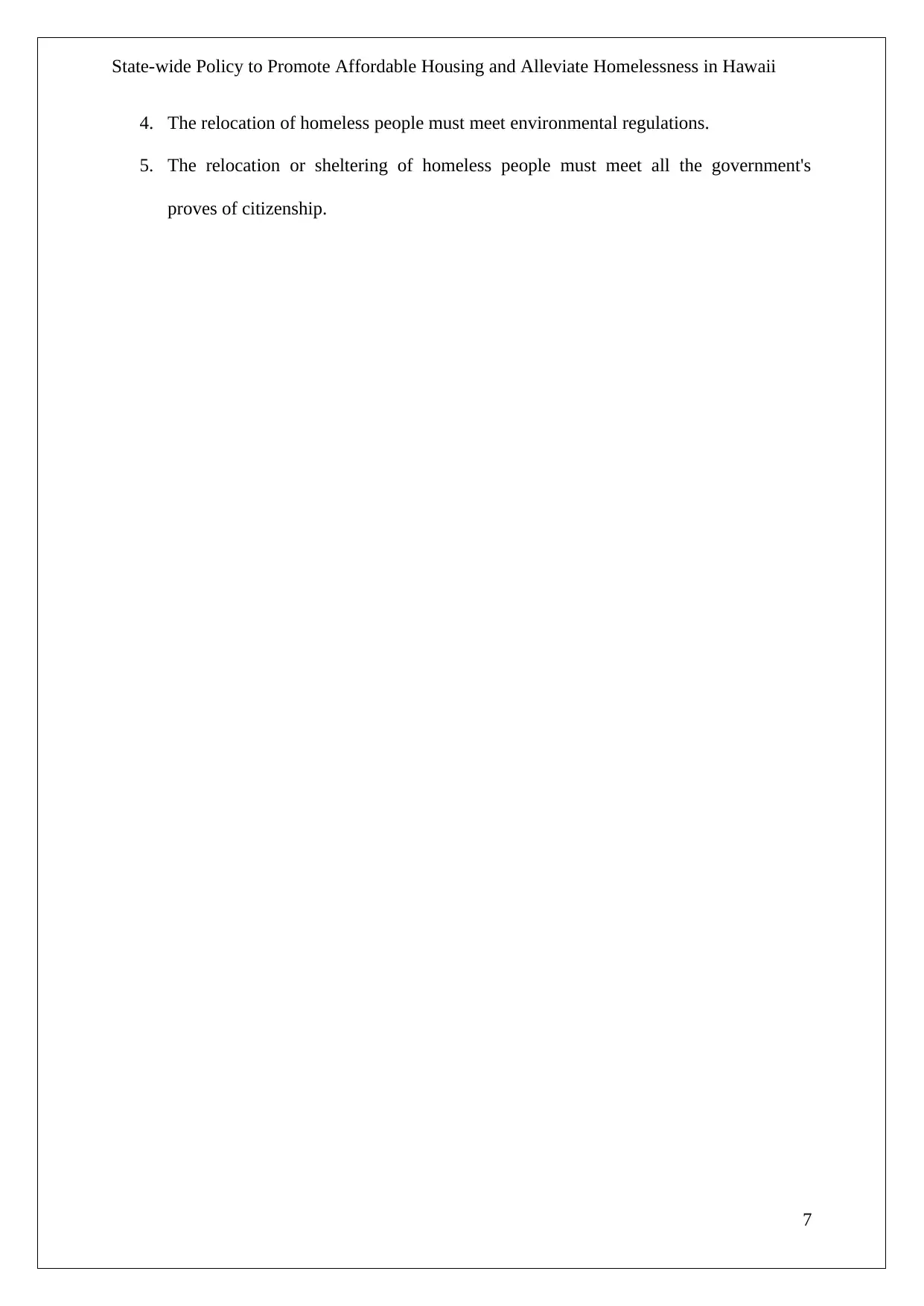
State-wide Policy to Promote Affordable Housing and Alleviate Homelessness in Hawaii
4. The relocation of homeless people must meet environmental regulations.
5. The relocation or sheltering of homeless people must meet all the government's
proves of citizenship.
7
4. The relocation of homeless people must meet environmental regulations.
5. The relocation or sheltering of homeless people must meet all the government's
proves of citizenship.
7
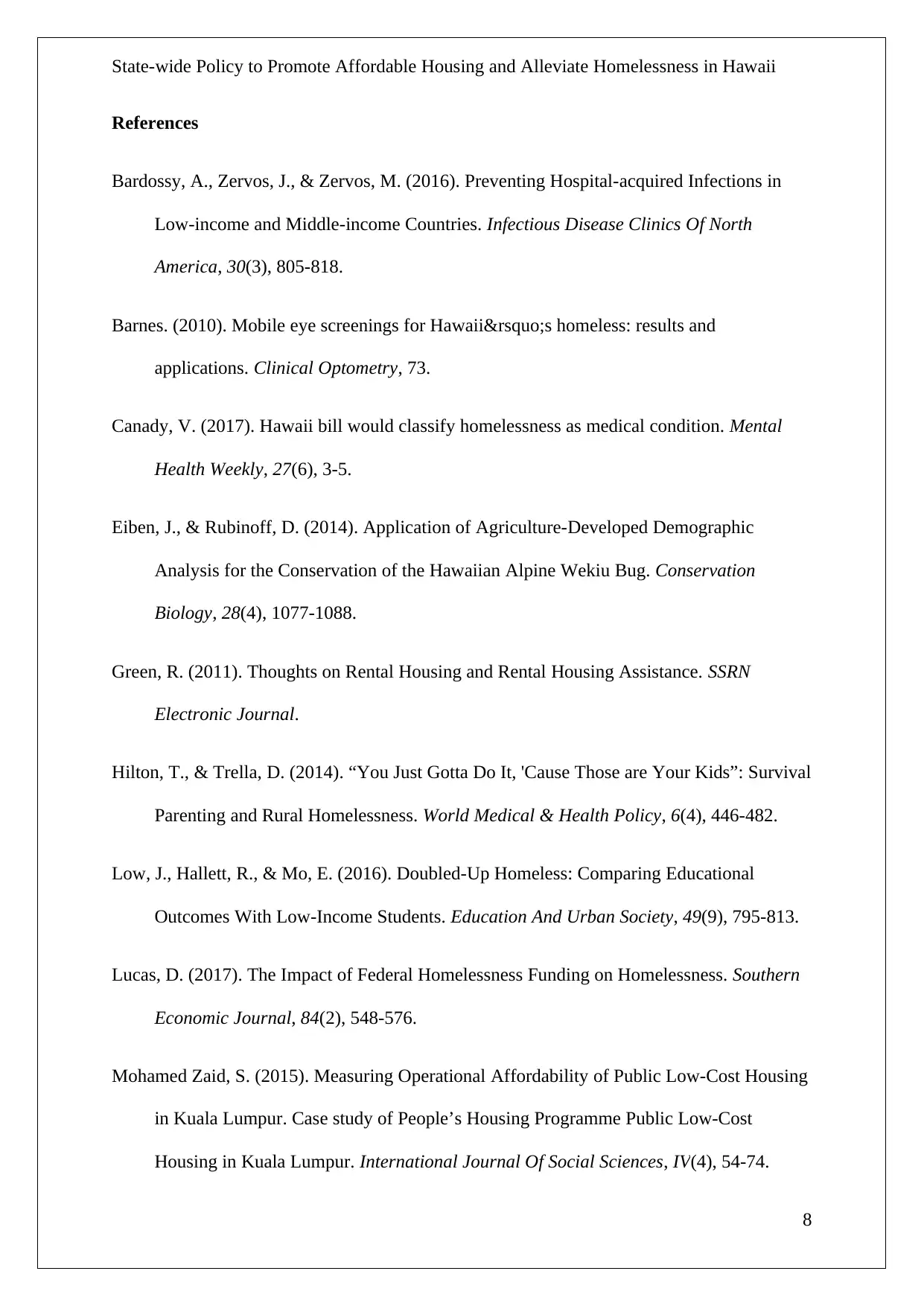
State-wide Policy to Promote Affordable Housing and Alleviate Homelessness in Hawaii
References
Bardossy, A., Zervos, J., & Zervos, M. (2016). Preventing Hospital-acquired Infections in
Low-income and Middle-income Countries. Infectious Disease Clinics Of North
America, 30(3), 805-818.
Barnes. (2010). Mobile eye screenings for Hawaii’s homeless: results and
applications. Clinical Optometry, 73.
Canady, V. (2017). Hawaii bill would classify homelessness as medical condition. Mental
Health Weekly, 27(6), 3-5.
Eiben, J., & Rubinoff, D. (2014). Application of Agriculture-Developed Demographic
Analysis for the Conservation of the Hawaiian Alpine Wekiu Bug. Conservation
Biology, 28(4), 1077-1088.
Green, R. (2011). Thoughts on Rental Housing and Rental Housing Assistance. SSRN
Electronic Journal.
Hilton, T., & Trella, D. (2014). “You Just Gotta Do It, 'Cause Those are Your Kids”: Survival
Parenting and Rural Homelessness. World Medical & Health Policy, 6(4), 446-482.
Low, J., Hallett, R., & Mo, E. (2016). Doubled-Up Homeless: Comparing Educational
Outcomes With Low-Income Students. Education And Urban Society, 49(9), 795-813.
Lucas, D. (2017). The Impact of Federal Homelessness Funding on Homelessness. Southern
Economic Journal, 84(2), 548-576.
Mohamed Zaid, S. (2015). Measuring Operational Affordability of Public Low-Cost Housing
in Kuala Lumpur. Case study of People’s Housing Programme Public Low-Cost
Housing in Kuala Lumpur. International Journal Of Social Sciences, IV(4), 54-74.
8
References
Bardossy, A., Zervos, J., & Zervos, M. (2016). Preventing Hospital-acquired Infections in
Low-income and Middle-income Countries. Infectious Disease Clinics Of North
America, 30(3), 805-818.
Barnes. (2010). Mobile eye screenings for Hawaii’s homeless: results and
applications. Clinical Optometry, 73.
Canady, V. (2017). Hawaii bill would classify homelessness as medical condition. Mental
Health Weekly, 27(6), 3-5.
Eiben, J., & Rubinoff, D. (2014). Application of Agriculture-Developed Demographic
Analysis for the Conservation of the Hawaiian Alpine Wekiu Bug. Conservation
Biology, 28(4), 1077-1088.
Green, R. (2011). Thoughts on Rental Housing and Rental Housing Assistance. SSRN
Electronic Journal.
Hilton, T., & Trella, D. (2014). “You Just Gotta Do It, 'Cause Those are Your Kids”: Survival
Parenting and Rural Homelessness. World Medical & Health Policy, 6(4), 446-482.
Low, J., Hallett, R., & Mo, E. (2016). Doubled-Up Homeless: Comparing Educational
Outcomes With Low-Income Students. Education And Urban Society, 49(9), 795-813.
Lucas, D. (2017). The Impact of Federal Homelessness Funding on Homelessness. Southern
Economic Journal, 84(2), 548-576.
Mohamed Zaid, S. (2015). Measuring Operational Affordability of Public Low-Cost Housing
in Kuala Lumpur. Case study of People’s Housing Programme Public Low-Cost
Housing in Kuala Lumpur. International Journal Of Social Sciences, IV(4), 54-74.
8
⊘ This is a preview!⊘
Do you want full access?
Subscribe today to unlock all pages.

Trusted by 1+ million students worldwide
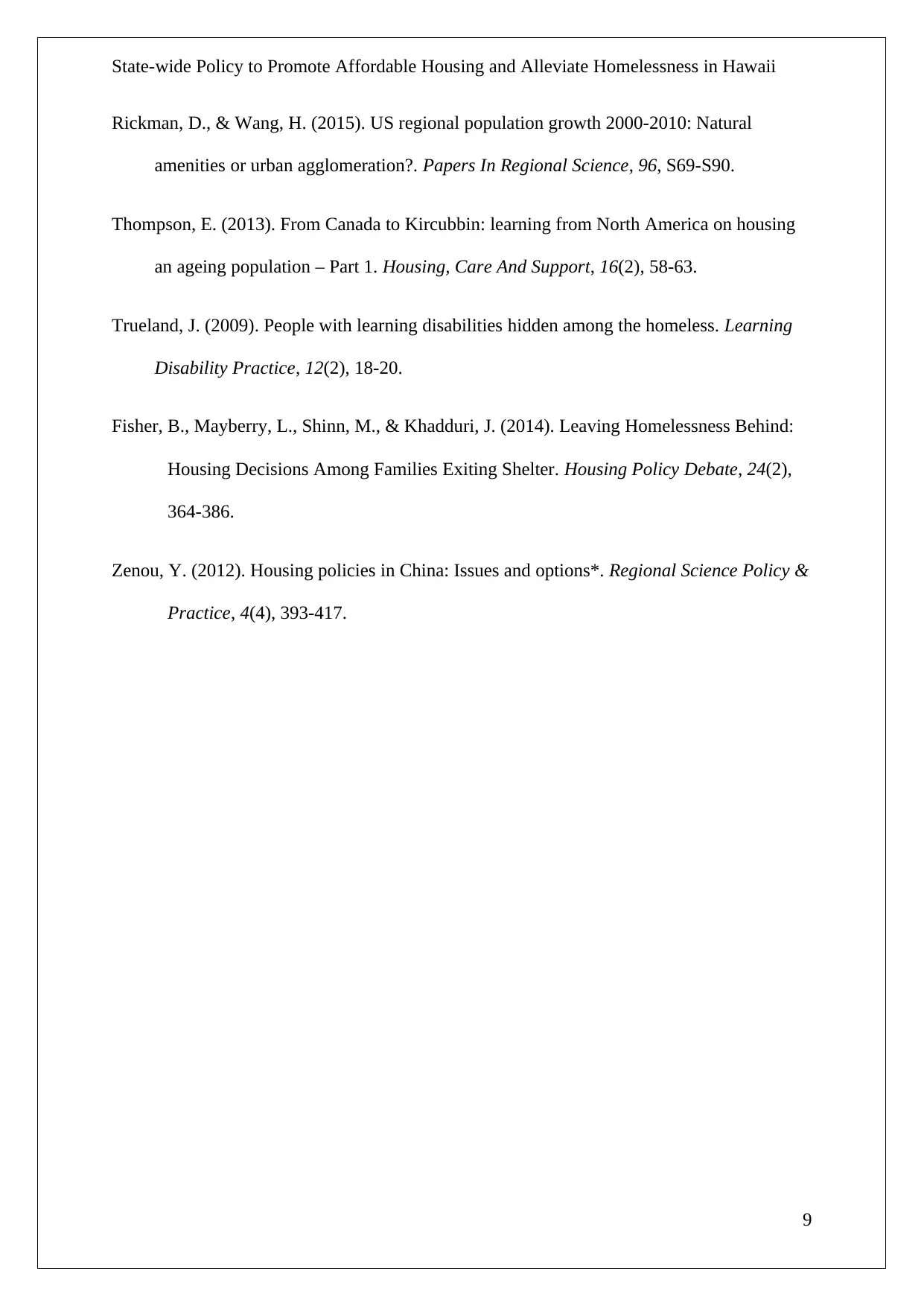
State-wide Policy to Promote Affordable Housing and Alleviate Homelessness in Hawaii
Rickman, D., & Wang, H. (2015). US regional population growth 2000-2010: Natural
amenities or urban agglomeration?. Papers In Regional Science, 96, S69-S90.
Thompson, E. (2013). From Canada to Kircubbin: learning from North America on housing
an ageing population – Part 1. Housing, Care And Support, 16(2), 58-63.
Trueland, J. (2009). People with learning disabilities hidden among the homeless. Learning
Disability Practice, 12(2), 18-20.
Fisher, B., Mayberry, L., Shinn, M., & Khadduri, J. (2014). Leaving Homelessness Behind:
Housing Decisions Among Families Exiting Shelter. Housing Policy Debate, 24(2),
364-386.
Zenou, Y. (2012). Housing policies in China: Issues and options*. Regional Science Policy &
Practice, 4(4), 393-417.
9
Rickman, D., & Wang, H. (2015). US regional population growth 2000-2010: Natural
amenities or urban agglomeration?. Papers In Regional Science, 96, S69-S90.
Thompson, E. (2013). From Canada to Kircubbin: learning from North America on housing
an ageing population – Part 1. Housing, Care And Support, 16(2), 58-63.
Trueland, J. (2009). People with learning disabilities hidden among the homeless. Learning
Disability Practice, 12(2), 18-20.
Fisher, B., Mayberry, L., Shinn, M., & Khadduri, J. (2014). Leaving Homelessness Behind:
Housing Decisions Among Families Exiting Shelter. Housing Policy Debate, 24(2),
364-386.
Zenou, Y. (2012). Housing policies in China: Issues and options*. Regional Science Policy &
Practice, 4(4), 393-417.
9
Paraphrase This Document
Need a fresh take? Get an instant paraphrase of this document with our AI Paraphraser

State-wide Policy to Promote Affordable Housing and Alleviate Homelessness in Hawaii
10
10
1 out of 11
Your All-in-One AI-Powered Toolkit for Academic Success.
+13062052269
info@desklib.com
Available 24*7 on WhatsApp / Email
![[object Object]](/_next/static/media/star-bottom.7253800d.svg)
Unlock your academic potential
Copyright © 2020–2025 A2Z Services. All Rights Reserved. Developed and managed by ZUCOL.